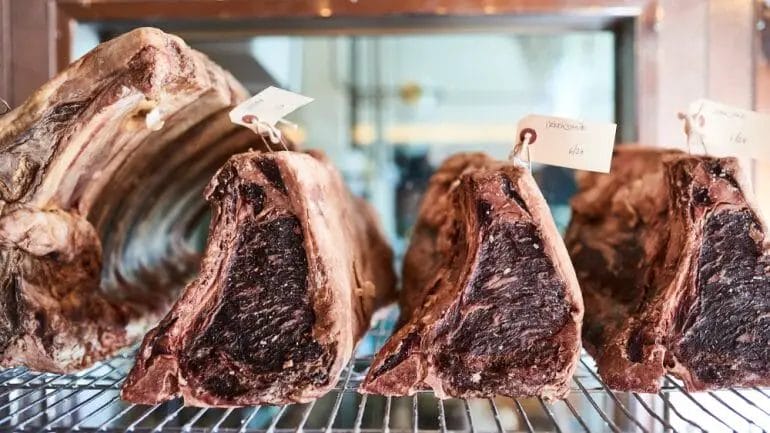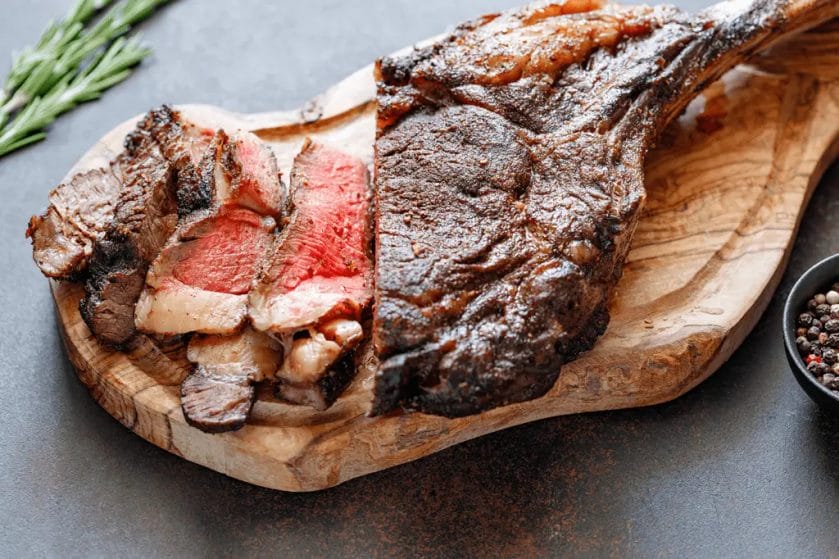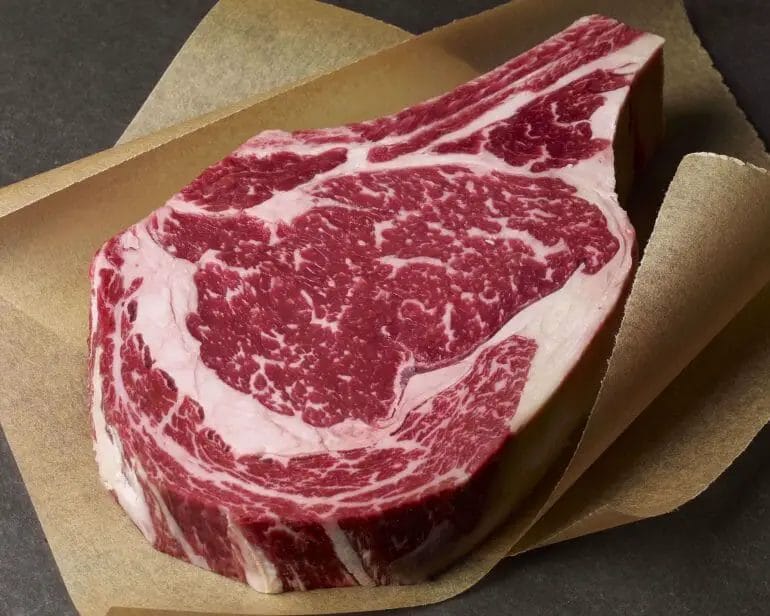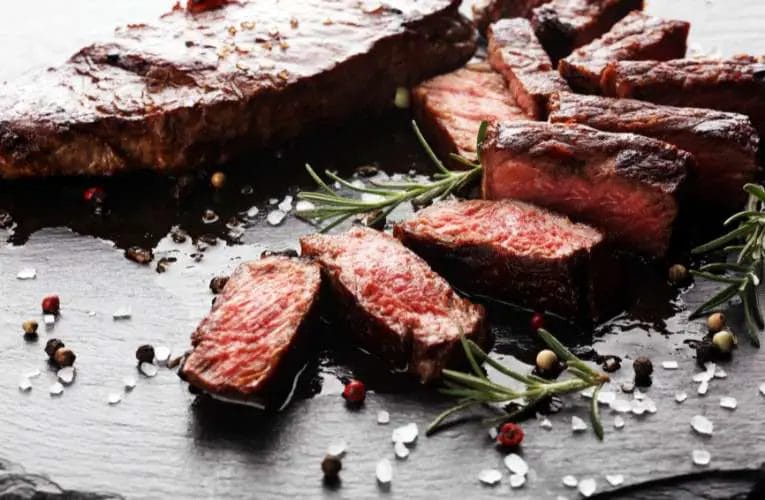A dry-aged steak is a culinary masterpiece that takes beef to the next level. It is a carefully aged cut of meat that undergoes a controlled process of dehydration, enhancing its flavor, tenderness, and richness.
The process involves storing the meat in a temperature and humidity-controlled environment for extended periods, allowing natural enzymes to break down the muscle fibers for a more tender texture.
The result is a steak with intensified flavors, buttery tenderness, and a unique level of complexity that leaves food enthusiasts craving for more.

The Art of Dry Aging: How Time and Temperature Transform the Taste and Texture
When it comes to meat, the process of dry aging is considered an art form in the culinary world. It is a method that involves aging meat, typically beef, in a controlled environment without the use of moisture.
This technique allows the natural enzymes in the meat to break down the muscle fibers, resulting in enhanced flavor and tenderness. In this section, we will explore the fascinating process of dry aging and how time and temperature play a crucial role in transforming the taste and texture of the meat.
The Basics of Dry Aging
Dry aging is a process that dates back centuries and was traditionally used as a preservation method before refrigeration became widely available. While it may seem counterintuitive to purposely let meat age and dry out, the results are truly remarkable.
During the aging process, the meat undergoes a series of chemical reactions that intensify its flavor while simultaneously tenderizing it.
The process begins by selecting high-quality cuts of beef, typically prime or choice grades, which have a higher fat content and marbling. These cuts are placed on racks in a temperature and humidity-controlled environment, usually a specialized cabinet or refrigerator.
The ideal temperature for dry aging ranges from 34°F to 40°F (1°C to 4°C), while the humidity should be kept around 80-85% to prevent excessive drying.
The Role of Time in Dry Aging
Time is a critical factor in the dry aging process. Most experts recommend aging beef for a minimum of 21 days, but it can be extended up to several months, depending on personal preference.
As the meat ages, enzymes naturally present in the muscle fibers start to break down the collagen, which is the tough connective tissue that gives the meat its rigidity. This breakdown of collagen results in increased tenderness and a melt-in-your-mouth texture.
Additionally, as the meat ages, it undergoes a process called proteolysis. This process involves the breakdown of proteins into amino acids and small peptides, which intensify the meat’s flavor.
The longer the aging period, the more pronounced the flavor becomes, with some describing it as nutty, earthy, or even slightly sweet.
The Impact of Temperature on Dry Aging
Temperature is another crucial element in the dry aging process. As mentioned earlier, maintaining a consistent temperature between 34°F and 40°F is essential to prevent spoilage and promote the enzymatic activity responsible for tenderizing the meat.
Too high of a temperature can lead to rapid bacterial growth, while lower temperatures may slow down the aging process significantly.
Some chefs and butchers also experiment with temperature fluctuations within this range to achieve specific results. For example, starting the aging process at a lower temperature for a few days, then gradually increasing it can result in a more pronounced flavor.
However, it requires careful monitoring to ensure that the meat remains safe to consume.
The Unique Characteristics of Dry Aged Meat
Dry aged meat offers a distinct taste and texture that sets it apart from traditionally aged or freshly cut meat. The flavor is often described as rich, intense, and deeply savory.
The combination of the breakdown of collagen and the accumulation of amino acids and peptides creates a unique umami flavor that is highly prized by meat enthusiasts.
In terms of texture, dry aged meat has a tender and buttery consistency. The extended aging process allows the muscle fibers to relax and become more tender, resulting in a melt-in-your-mouth experience.
The fat within the meat also undergoes changes, becoming creamier and enhancing the overall richness of the meat.
Mastering the Art of Dry Aging
Dry aging requires skill, knowledge, and patience. It is a delicate process that should be done in a controlled and sanitary environment.
While it is possible to dry age meat at home, it is recommended to seek the expertise of a professional butcher or supplier who has the necessary equipment and experience.
When the time comes to enjoy a dry aged steak, it is best to cook it simply to let the natural flavors shine. Whether you prefer a classic pan-seared steak or a perfectly grilled masterpiece, the enhanced taste and tenderness of dry aged meat will elevate your dining experience to new heights.

Dry Aging vs. Wet Aging: Which Method Produces the Best Steak?
When it comes to enjoying a delicious, juicy steak, the method used to age the meat plays a significant role in determining its flavor, tenderness, and overall quality.
Two popular methods of aging steaks are dry aging and wet aging. Both techniques have their own unique characteristics and advantages. In this section, we will compare dry aging and wet aging to determine which method produces the best steak.
Dry Aging
Dry aging is a traditional method of aging beef that involves hanging large cuts of meat, such as ribeye or sirloin, in a controlled environment with specific temperature and humidity conditions.
The meat is left to age for several weeks, allowing natural enzymes to break down the muscle fibers, resulting in a more tender and flavorful steak.
One of the key benefits of dry aging is the concentration of flavors. As the moisture evaporates from the meat, the flavors become more intense, resulting in a rich and robust taste.
Additionally, the natural enzymes present in the meat break down the connective tissues, resulting in a tender and melt-in-your-mouth texture.
However, dry aging also has its drawbacks. It requires a considerable amount of time and space, as well as careful monitoring of temperature and humidity levels. Moreover, a significant amount of moisture loss occurs during the aging process, which leads to a reduction in weight and yield.
Wet Aging
Wet aging, also known as vacuum aging, is a relatively newer method of aging steaks. In this process, the meat is placed in a vacuum-sealed bag and aged in a refrigerated environment. Unlike dry aging, wet aging allows the meat to retain its moisture, resulting in a juicier and more tender steak.
One of the significant advantages of wet aging is the convenience and efficiency it offers.
The vacuum-sealed bags prevent any moisture loss, ensuring that the steak remains moist and tender throughout the aging process. Additionally, wet aging requires less space and time compared to dry aging.
However, one drawback of wet aging is the lack of flavor concentration. Since the moisture is retained in the meat, the flavors do not intensify as much as they do in dry aging.
The result is a milder flavor profile compared to dry-aged steaks. Furthermore, the absence of moisture loss means that the connective tissues do not break down as extensively, resulting in a slightly less tender texture.
Which Method Produces the Best Steak?
Deciding which method produces the best steak ultimately comes down to personal preference. If you enjoy a more intense and complex flavor profile, a dry-aged steak may be the ideal choice for you.
The concentrated flavors and tender texture achieved through the aging process can create a truly memorable dining experience.
On the other hand, if you prefer a steak that is incredibly juicy and maintains its natural moisture, a wet-aged steak may be more to your liking. The convenience and shorter aging period of wet aging make it a popular choice among many steak enthusiasts.
It’s worth noting that the best steakhouses around the world often use dry aging to enhance the flavor and tenderness of their premium cuts. Dry-aged steaks are considered a delicacy and are typically more expensive due to the additional time and effort required in the aging process.
Ultimately, the choice between dry aging and wet aging depends on your personal preferences and the dining experience you seek. Whether you opt for a dry-aged steak or a wet-aged one, both methods can deliver a memorable and delectable eating experience.

The Perfect Cut: Exploring the Best Cuts of Meat for Dry Aging
Dry aging is a process that enhances the flavor and tenderness of meat by allowing it to age in a controlled environment. It’s a traditional method that dates back centuries, and it’s still widely practiced today by chefs and meat enthusiasts alike.
However, not all cuts of meat are suitable for dry aging. In this section, we will explore the best cuts of meat that lend themselves well to this unique process.
1. Ribeye
The ribeye steak is often hailed as the king of steaks, and for good reason. It is well-marbled with fat, which adds incredible flavor and tenderness to the meat.
When dry aged, the ribeye develops even more depth of flavor, as the aging process allows the natural enzymes to break down the muscle fibers and intensify the meat’s natural characteristics. The result is a rich, buttery, and melt-in-your-mouth steak that is sure to impress.
2. Striploin
The striploin, also known as New York strip or sirloin strip, is another popular choice for dry aging. It is a leaner cut compared to the ribeye, but it still offers a good amount of marbling and tenderness.
Dry aging enhances the striploin’s natural flavors and creates a unique combination of juiciness and chewiness. It’s a versatile cut that can be cooked to various levels of doneness, making it a favorite among steak lovers.
3. Tenderloin
The tenderloin, often referred to as filet mignon, is known for its exceptional tenderness. It is the most tender cut of beef, with minimal marbling and a mild flavor.
While dry aging may not significantly alter the texture of the tenderloin, it can enhance its natural flavors and add a subtle complexity to the meat. Dry-aged tenderloin is incredibly tender and buttery, making it a top choice for those who prefer a milder taste.
4. T-Bone and Porterhouse
The T-bone and porterhouse steaks offer the best of both worlds. They consist of two cuts of beef separated by a T-shaped bone – the tenderloin on one side and the striploin on the other.
Dry aging these cuts allows both the tenderloin and striploin to develop their unique flavors and become more tender. The result is a steak with a rich, beefy taste and a combination of melt-in-your-mouth tenderness and a robust texture.
5. Tomahawk Steak
The tomahawk steak is a bone-in ribeye with an elongated bone, resembling a tomahawk axe. This impressive cut not only looks visually stunning but also delivers a fantastic flavor profile when dry aged.
The tomahawk steak is incredibly well-marbled, which means it benefits greatly from the aging process. As the meat ages, it becomes more tender, and the fat melts into the muscle, creating an unmatched buttery and savory taste.

Mastering the Dry Aging Process: Tips and Techniques for Home Chefs
Dry aging is a technique used by professional chefs and butchers to enhance the flavor and tenderness of meat. Traditionally, this process was only done in specialized facilities, but with the right knowledge and equipment, home chefs can now master the art of dry aging in the comfort of their own kitchen.
In this section, we will explore the tips and techniques that will help you become a pro at dry aging.
1. Choosing the Right Cut of Meat
The first step to successful dry aging is selecting the right cut of meat. Opt for cuts with a good amount of intramuscular fat, such as ribeye, strip loin, or sirloin. The fat content is vital as it adds flavor and prevents the meat from drying out during the aging process.
Ensure that you purchase a well-marbled piece of meat with a thick layer of fat on the outside. This layer will protect the meat from excessive moisture loss and allow it to develop the desired flavors.
2. Preparing the Meat
Before you begin the dry aging process, it is crucial to properly prepare the meat. Start by trimming off any excess fat or silver skin to ensure even aging. Leaving too much fat on the meat can result in an unpleasant flavor and texture.
Next, season the meat with kosher salt. The salt will draw out moisture from the surface of the meat, helping to create a dry environment for aging. You can also add additional seasonings or spices to enhance the flavor, but keep it simple to allow the natural taste of the meat to shine through.
3. Creating the Ideal Aging Conditions
The key to successful dry aging is creating the ideal environment for the meat to age. The optimal temperature for dry aging is between 34°F to 38°F (1°C to 3°C) with a humidity level of around 85%.
These conditions allow for the growth of beneficial enzymes and the breakdown of collagen, resulting in tender and flavorful meat.
To achieve these conditions, you will need a dedicated refrigerator or a dry aging cabinet. These specialized units are equipped with temperature and humidity controls, ensuring a consistent environment for the aging process.
Make sure to clean and sanitize the unit before use to avoid any contamination.
4. Patience is Key
Dry aging is not a quick process; it requires patience. The optimal aging period for most cuts of meat ranges from 21 days to 45 days. During this time, the meat will go through a natural enzymatic process that enhances its tenderness and flavor.
It is important to regularly check the meat during the aging process for any signs of spoilage. If you notice any unpleasant odors or mold growth, it is best to discard the meat to avoid foodborne illnesses.
5. Trim and Cook
Once the desired aging period is complete, it’s time to trim and cook the dry-aged meat. Start by removing the outer crust, which may have developed a dark, leathery texture. This outer layer is not suitable for consumption but can be used to enhance the flavor of stocks or sauces.
After trimming, cook the meat using your preferred method. Dry-aged meat is known for its intense flavor and tenderness, so keep the seasoning simple to allow the natural flavors to shine.
Whether you choose to grill, roast, or pan-sear the meat, make sure to let it rest before slicing to ensure maximum juiciness.

FAQs
Q: What is a dry-aged steak?
A: Dry-aged steak is a process where large cuts of beef are aged, usually in a controlled environment, for several weeks. This process allows the meat to lose moisture, resulting in a more concentrated flavor and tender texture. The aging process also helps develop a unique nutty and earthy taste in the steak.
Conclusion
In conclusion, dry-aged steak is a culinary delight that offers an exceptional dining experience. The unique process of dry-aging allows the meat to develop complex flavors and a tender texture that simply cannot be replicated.
The intense concentration of flavors and the rich marbling make each bite a true indulgence. Whether you prefer a ribeye, a striploin, or a tenderloin, the dry-aging process enhances the natural qualities of the meat, resulting in an unforgettable feast for the senses.
In addition to the incredible taste, dry-aged steak also offers health benefits. The aging process helps to break down connective tissues and enzymes, making the meat more digestible.
It is also known to have higher levels of essential nutrients, including vitamins and minerals. So, not only is dry-aged steak a gourmet treat, but it also contributes to a well-rounded and nutritious diet.
Indulge yourself in the culinary experience of dry-aged steak and savor the exquisite flavors that can only be achieved through this traditional and time-honored technique.

